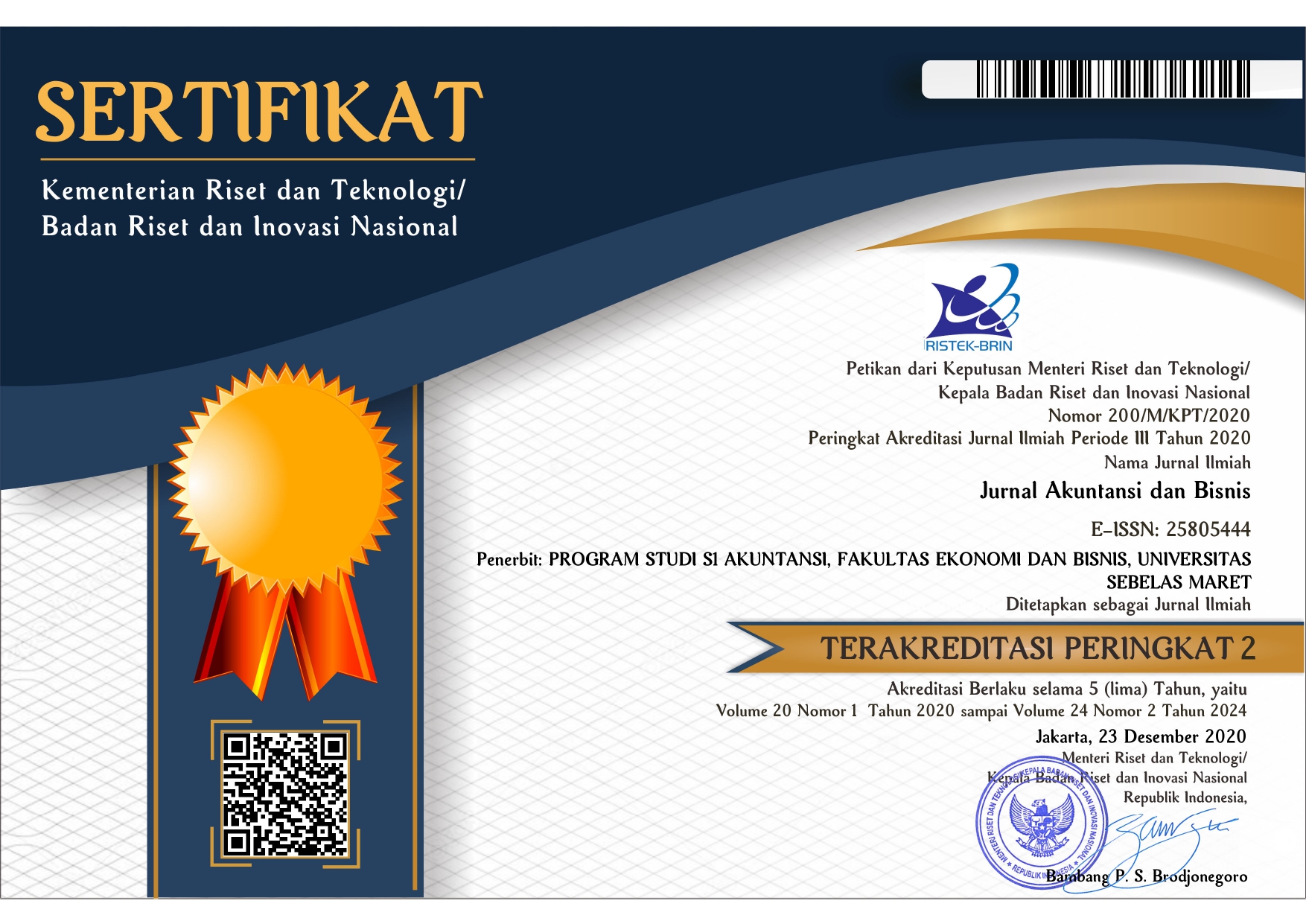Analisis Hubungan Activity-Based Costing dengan Peningkatan Kinerja Keuangan (Studi Empiris di Bursa Efek Jakarta)
Abstract
References
Abdul H., Achmad T., dan Fakhri H.. 2000. Sistem Pengendalian Manajemen. Edisi Revisi. Cetakan Pertama. AMP YKPN, Yogyakarta.
Barnes, F. C.. 1991. IES Can Improve Management Decisions Using Activity-Based Costing. Industrial Engineering, September: 44-50.
Bjornenak, T.. 1997. Diffusion and accounting: the case of ABC in Norway. Management Accounting Research. 8: 3-17.
Bjornenaqk, T., and Mitchell, F. 1999. A Study of the Development of the Activity-Based Costing Journal Literature 1987-1998. Working Paper. University of Pittsburgh.
Blocher, E.J., Chen, K.H., dan Lin, T.W.. 2000. Manajemen Biaya. Edisi Pertama. Cetakan Pertama. Salemba Empat, Jakarta.
Cagwin, D. dan Bouwman, M.J.. 2002. The Association Between Activity-Based Costing and Improvement in Financial Performance. Journal of Management Accounting Research, 13: 1-39.
Carter and Usry. 2002. Akuntansi Biaya. Edisi 13, Cetakan 1, Salemba Empat.
Cooper, R. and Turney, P. B.. 1989. Hewlett-Packard: the Roseville Network Division. Boston , MA. Harvard Business School, (Case No. 9-189-117).
Dillon, W.R.. 1984. Multivariate Analysis Method and Aplications. John Willey dan Sons, Inc., Maltehew Goldstein School of Management University of Massahusett.
Dixon, J. M.. 1996. Total Quality Management in ISO-9000 Registered Organizations: an Empirical Examination of the Critical Characteristics Associated with Levels of Financial Performance. Dissertation. Florida State University.
Drake, A. R.. 1999. Cost System and Incentive Structure Effects on Innovation. Efficiency and Profitability in Teams.
Eny R.. 2003. Pengaruh Strategi Inovasi Terhadap Kinerja Keuangan Operasional Perusahaan Manufaktur Di Indonesia. Tesis. Fakultas Ekonomi Universitas Gajah Mada. Tidak dipublikasi.
Ferdinand, A.. 2002. Structural Equation Modeling dalam Penelitian Manajemen. Edisi Kedua. Fakultas Ekonomi UNDIP, Yogyakarta.
Georgantzas, N. C. and Shapiro, H. J.. 1993. Viable Theoretical Form Of Synchronous Production Innovation. Journal of Operations Management, 11: 161-183.
Gordon, L. A., and Silvester, K. J.. 1999. Stock market reactions to activity-based costing adoptions. Journal of Accounting and Public Policy, 18, September: 229-251.
Hair, J. F.. 1998. Multivariate data Analysis. Fitth Edition. Prentice Hall International, Inc.
Hicks, D. T.. 1999. Yes, ABC is for small business too. Journal of Accountancy, 188, August: 41-43.
Krumwiede, K. R.. 1996. An Empirical Examination of Factors Affecting the Adoption and Infusion of Activity-Based Costing. Dissertation. University of Tennessee.
Krumwiede, K. R.. 1998. The Implementation Stages of Activity-Based Costing and The Impact of Contextual and Organizational Factors. Journal of Management Accounting Research, 10: 239-277.
Mia, L. and Clarke, B.. 1999. Market Competition, Management Accounting Systems and Business Unit Performance. Management Accounting Research, 10: 137-158.
Munawir S.. 1995. Analisis Laporan Keuangan. Edisi Keempat. Liberti, Yogyakarta.
Pattison, D. D. and Arendt, C. G.. 1994. Activity Based Costing: It Doesn’t Work All The Time. Management Accounting, April: 55-61.
Rayburn, M. R.. 1999. Activity-based costing Internal Auditor, December, 45-51.
Reeve, J. M.. 1996. Projects, Models, and Systems-Where is ABM Headed?. Journal of Cost Management, 10: 5-15.
Robert, M. W. and Silvester, K. J.. 1996. Why ABC Failed and How it May Yet Succeed. Journal of Cost Management. Winter: 23-35.
Shields, M. D.. 1995. An Empirical Analysis of Firm’s Implementation Experiences With Activity-Based Costing. Journal of Management Accounting Research, Fall: 148-166.
Smith, M.. 2000. Innovation Diffusion, Management Accounting, 78, June: 40-41.
Swenson, D.. 1995. The Benefits of Activity-Based Cost Management to The Manufacturing Industry. Journal of Management Accounting Research, Fall: 167-180.
Swenson, D. W.. 1998. Managing Costs Though Complexity Reduction at Carrier Corporation. Management Accounting, April: 20-28.
Tabachnick, B. G. dan Fidell, L. S.. 1996. Using Multivariate Statistics. 3rd Edition, New York, Harpercollins.
Vinni T. M., 2003. Analisis Optimalisasi Biaya Mutu Produk pada PT. Kusumatex Yogyakarta. Skripsi. Fakultas Ekonomi Universitas Muhammadiyah Yogyakarta, Tidak dipublikasi.
DOI: http://dx.doi.org/10.20961/jab.v7i2.71
Jurnal Akuntansi dan Bisnis (JAB)
ISSN 1412-0852 (print), 2580-5444 (online)
Published by Accounting Study Program, Faculty of Economics and Business, Universitas Sebelas Maret, Indonesia

JAB on http://jab.fe.uns.ac.id/index.php/jab is licensed under a Creative Commons Attribution-ShareAlike 4.0 International License










